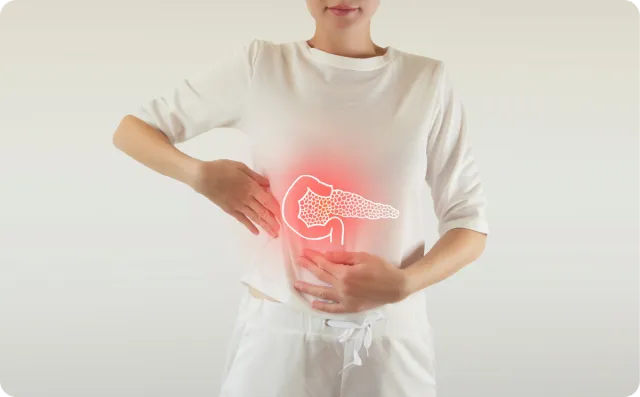
Jump to
Book a visit
$25 typical copay
$150 without insurance
Get answers today about your stool color concerns from a GI specialist.
A virtual GI consultation lets you discuss stool color changes with an expert, helping you identify potential causes and the next steps in your treatment.
Key takeaways:
- There are only a few causes of blue poop, making it easy to identify the underlying problem.
- Most causes of blue poop are benign and due to dietary choices.
- Reviewing your medication list and any other associated symptoms can help your healthcare provider easily identify a cause.
Experiencing blue poop can be a shock. While changes in stool color can often be traced back to dietary choices or medications, blue stool can indicate something more serious in rare cases.
This article will cover the most common causes of blue poop, what you can do to address the symptom on your own, and when to consult a healthcare professional for further intervention. Understanding these aspects can help you determine whether this unusual symptom is a cause for concern or simply something that will pass on its own.
Is blue poop normal?
While it might be hard to use the words “normal” and “blue poop” together in the same sentence, this colorful symptom may be perfectly benign.
Depending on what you eat and drink, it might in fact be normal to see stool that is blue in color. Reviewing a full medical history including diet, medications, and additional symptoms can differentiate between normal cases of blue poop, and abnormal cases of blue poop.
Causes of blue poop
There aren’t many causes of blue poop, however, there are a few potential causes that you should be aware of in case you ever experience this unusual symptom.
Dietary choices
Eating naturally blue foods and foods colored with blue food coloring are known to cause blue stool.
Interestingly enough, the ability of blue food dye to change the color of stool has been used in studies to track gut transit time by giving participants muffins dyed with royal blue food coloring and then measuring the amount of time it takes for the stool to appear blue.
Medical conditions
Porphyria refers to a group of eight different metabolic disorders that are categorized by breaking down a component of blood known as heme.
These disorders can lead to an accumulation of metabolites in both the urine and the stool and may give them both a blue discoloration. Porphyrias are fairly rare and typically have additional symptoms such as abdominal and muscle pain, digestive issues such as constipation, nausea, and vomiting, and can even cause an altered mental state.
Medications
It is possible for the ingestion of certain chemicals and medications to cause a blue discoloration of the poop.
Examples include boric acid (used to treat infected wounds and also used to treat bacterial vaginosis and vaginal candidiasis infections), methylene blue (used to treat methemoglobinemia), and chloramphenicol (an antibiotic used for treating bacterial infections).
Always make sure to let your healthcare provider know about all medications that you are taking, especially when you are experiencing an unusual symptom.
Infections
Certain bacterial infections in the intestines can cause discoloration of stool. Intestinal infections caused by Pseudomonas aeruginosa are associated with blue-green-colored poop.
This type of infection can be transmitted through contaminated food and water, openings in the skin, and contact with others who are infected and requires an evaluation by a healthcare provider and treatment with antibiotics.
What blue poop may mean based on appearance, consistency, or another symptom or condition
Blue poop can indicate different health conditions and causes that need to be properly identified to receive the correct treatment. Additional details about appearance, consistency, or other symptoms can help your healthcare provider narrow in on a possible diagnosis:
- Blue and green poop: Blue-green poop is often the result of infection with the bacteria known as Pseudomonas aeruginosa. Other times, it is simply a result of eating blue or green foods or foods containing blue or green food dye.
- Hard blue poop: Hard blue poop may suggest dehydration or a lack of dietary fiber, combined with the consumption of blue dyes or foods.
- Loose blue poop: Loose blue stools may be the result of dietary choices. Consuming foods or drinks with large amounts of blue food dye can lead to both diarrhea and blue discoloration of the stool. In some cases, loose blue stools can be the result of a gastrointestinal tract infection caused by a bacteria, virus, or parasite.
- Blue poop while pregnant: Blue poop while pregnant can be due to any of the aforementioned conditions (dietary choices, medications, infections). If you are experiencing any abnormal stool colors while pregnant, you should speak with your healthcare provider.
Read our guide on different types of stool for more.
When to see a doctor about blue poop
If you experience blue poop, you can almost always link its appearance to something you ate or drank.
However, there are a few situations where it is important to consult a healthcare professional. Knowing when to see your primary care provider vs when to be seen in the ER can help you better navigate this unusual symptom.
You should see a doctor if:
- You experience persistent blue poop lasting more than a couple of days.
- There are accompanying symptoms like abdominal pain or significant changes in bowel habits.
- You have a history of gastrointestinal issues.
- You are unable to link this symptom to dietary choices or something you ate in the preceding few days.
You should go to the emergency room if:
- You have blue poop with severe abdominal pain or cramping.
- There is significant blood in your stool, regardless of color.
- You experience associated symptoms like blue urine or vomit which could indicate chemical poisoning or altered mental status which could indicate an underlying metabolic condition.
Questions to ask your doctor about blue poop
- What could be causing my blue poop?
- Is this a result of something contagious? If so, how long am I contagious for?
- Should I make any dietary changes to address my symptoms?
- What treatment options are available for my symptoms?
How to stop or treat blue poop
In order to treat or stop blue poop, it is vital to first identify the underlying cause. Treatment will then be tailored to address the root cause of the issue.
Dietary changes
If you consume a lot of foods that are naturally blue such as blueberries, plums, and currants, and even foods with artificial blue coloring, you should expect to see blue stools.
When diet is the cause of this symptom, it is completely benign. Despite being benign, if seeing the color blue in your poop is bothersome to you, making changes to your diet can quickly stop this symptom.
Address underlying condition
If you have an underlying medical condition such as a metabolic disorder like porphyria, treatment with IV fluids containing glucose as well as management with maintenance medications can help eliminate some of the symptoms.
Similarly, treating underlying acute gastrointestinal infections like pseudomonas with appropriate antibiotics may be necessary as well.
Supportive measures
Supportive measures such as increasing fluids and eating a balanced diet high in fiber can help move things through the gastrointestinal tract and quickly get your stool back to a normal color.
These supportive measures alongside taking an over-the-counter probiotic can also be helpful in restoring gut health when the cause of this symptom is due to a bacterial, viral, or parasitic infection.
Frequently asked questions: blue poop
You likely still have some questions regarding blue poop. Here are the answers to some of the most commonly asked questions about this rarely-seen symptom.
Can blue dye cause blue poop?
Yes, blue dyes used in foods and drinks, such as blue dye no. 1 (referred to as brilliant blue), and blue dye no. 2 (referred to as indigo carmine) can lead to blue poop. Oftentimes, the dye is not fully broken down during digestion, resulting in the color change.
What foods or drinks cause blue poop?
Some foods that can cause poop to turn blue include blueberries, currants, plums, and foods colored with blue food dye. Blue juices, sodas, and liquors can also cause blue poop.
Managing blue poop
Understanding the causes of blue poop can help eliminate the sense of alarm when experiencing this symptom. While it is often linked to dietary choices, it can occasionally signal a more serious condition, particularly related to gastrointestinal health. If you experience persistent blue stool or additional concerning symptoms alongside blue stool and you are not able to directly attribute it to something you recently ate or drank, you should consult a healthcare provider for further evaluation.
General Medicine follows a strict editorial process, including using real experts to write our articles, vetted primary sources, fact-checking, a secondary medical review, and updates as necessary. This article was medically reviewed and fact checked by Dr. Marjorie Bravard, MD.
Sources
Asnicar, Francesco et al. “Blue poo: impact of gut transit time on the gut microbiome using a novel marker.” Gut vol. 70,9 (2021): 1665-1674. doi:10.1136/gutjnl-2020-323877 https://pmc.ncbi.nlm.nih.gov/articles/PMC8349893/
Christensen, Buck. “Discoloration, Feces: Discoloration, Feces.” Medscape.com, Medscape, 20 Apr. 2023, emedicine.medscape.com/article/2172377-overview. Accessed 30 Oct. 2024.
Di Pierro, Elena et al. “Laboratory Diagnosis of Porphyria.” Diagnostics (Basel, Switzerland) vol. 11,8 1343. 26 Jul. 2021, doi:10.3390/diagnostics11081343 https://pubmed.ncbi.nlm.nih.gov/34441276/
Lee, S K, and S M King. “Blue-green stools and Pseudomonas aeruginosa.” The Pediatric infectious disease journal vol. 9,5 (1990): 371-2. doi:10.1097/00006454-199005000-00015 https://pubmed.ncbi.nlm.nih.gov/2112739/
Olas, Beata et al. “The Effects of Natural and Synthetic Blue Dyes on Human Health: A Review of Current Knowledge and Therapeutic Perspectives.” Advances in nutrition (Bethesda, Md.) vol. 12,6 (2021): 2301-2311. doi:10.1093/advances/nmab081 https://pubmed.ncbi.nlm.nih.gov/34245145/
Our editorial standards
At General Medicine, we cut through the clutter to make health care clearer, faster, and easier to navigate. Every article is grounded in evidence-based research and peer-reviewed journals, reviewed by medical professionals, and written in accessible language that helps you make health decisions with confidence. We’re committed to ensuring the quality and trustworthiness of our content and editorial process by providing information that is up-to-date, accurate, and actually useful. For more details on our editorial process, see here.



